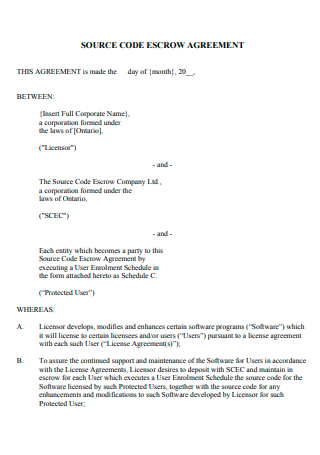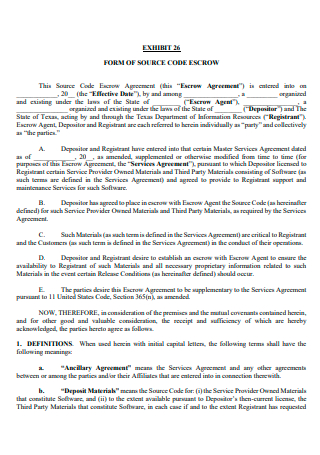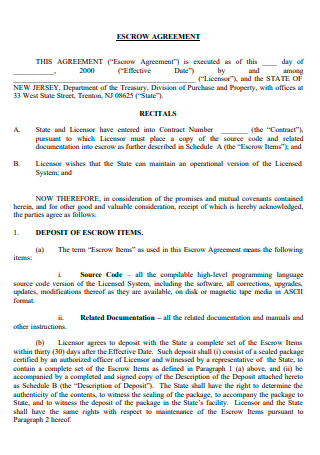4+ Sample Source Code Escrow Agreement
FREE Source Code Escrow Agreement s to Download
4+ Sample Source Code Escrow Agreement
What Is a Source Code Escrow?
Benefits of Source Code
Tips for Building Better Software Products
How to Ace Software Contract Negotiations
FAQs
Why is source code important?
Can source code be stolen?
What do hackers do with source code?
What Is a Source Code Escrow?
Typically, a source code escrow agreement orders the agent to disclose the source code to the licensee upon a defined event, such as the licensor’s insolvency or breach of its maintenance duties under the prior license agreement. A three-party escrow agreement specifies the agent’s, licensor’s, and licensee’s respective rights and responsibilities. According to Iron Mountain, 97.4% of all analyzed escrow material deposits needed to be completed, and 74% required extra developer input to be compiled.
Benefits of Source Code
With the rapid rise of cybercrime and the increasing demand for system performance, IT security is assuming a more prominent role. Traditional techniques such as firewalls and antivirus software cannot combat the complex, ever-changing threat environment that hackers and malware create. The emerging consensus in the industry is that good security must begin with the source code. Source code analysis is a static application security assessment that examines the program’s source code for potential security vulnerabilities. Here are the benefits of employing this method.
Tips for Building Better Software Products
In a competitive market, the quality of your software products is a distinct advantage. Therefore, you must understand how to develop superior software for your target audience. Marketing is an effective method for increasing brand awareness. However, the quality of your software goods is what drives sales. Therefore, it is essential to establish a positive reputation by developing the most excellent software. The software development sector is saturated with rivals. But there is no cause for concern; there are ways to become the best. Here are some tips for developing software products to help you reach the top of the market.
1. Prioritize the value of your product to your clients.
Do you have a clear view of the capabilities of your product? If not, you cannot go appropriately with the rest. When you understand its purpose for your end customers, you can assess its functionality, design, and implementation. Developing a product based on ideal attributes sounds enjoyable. However, you must first establish the worth of your product to your target market.
2. Concentrate on creating a fantastic user experience
Since 2020, UX designers have been in high demand for a reason. Businesses realize that user experience is crucial for software solutions. When building a product, you should give everyone a gratifying experience. As much as possible, maintain simplicity and usability. Ensure that its design matches their tastes and preferences. Additionally, features should be simple to learn and employ. When consumers encounter hassles when using a product, they seek alternatives.
3. Assess the market properly
You can only genuinely comprehend how to service a clientele if you know their demographics. Consequently, every entrepreneur in the software development sector must implement the concept of product-market fit. Initially, it is essential to define your target market properly. Once you have the demographic information, analyze their preferences and needs. Additionally, you can attempt to dissect their possible behavior while utilizing the goods. You can also do a competitor analysis. Consider both their strengths and faults, as well as any market gaps they may have left behind. And when you’re ready to advertise your software, highlight its data-supported advantages over the competition.
4. Utilize and evaluate the software as an end-user
One must be one to know one. You’ve likely heard this expression a hundred times. However, it also applies to developing software products. It implies that you must become a user to design better software. As you use the software frequently, you can identify potential bugs and other issues. It could pertain to the interface, the user experience, or a functional problem. You might even consider adding new features along the road.
5. Utilize contemporary development tools and techniques
The technological wave is introducing Moderner tools to the software development industry. Even better, you may use several technologies to automate the testing procedure. For instance, you can use platforms for rapid application development. Compared to the conventional programming life cycle, this aids in time and resource savings.
How to Ace Software Contract Negotiations
Successful software contract talks require previous planning, a good team and strategy, and prompt decisions. Negotiating a software contract is difficult, whether it’s your first or fifth time. You must ensure that the software satisfies your business requirements and that the seller is not overcharging you or changing critical contract conditions. Negotiating software is a team activity involving extensive planning and a sound approach. Preparation begins well in advance of meeting with the vendor’s sales staff. Before an agreement can be finalized, weeks or often even months of study, negotiations, and changes are required. This article offers five steps for negotiating a software contract successfully.
1. Form a purchasing/negotiation team
Having a skilled team to assist you during the software selection and negotiation phases will ensure you sign a beneficial contract. Include associates with broad business experience to obtain input from multiple business units on software choices. Determine the required software features, budget report, ideal contract length, etc., as a team.
2. Conduct thorough research
Learn as much as possible about the vendors you are negotiating with, and maintain an inquiring position throughout negotiations. According to Gartner, 45% of a B2B buying group’s time is spent researching while considering a purchase. You can create a shortlist of vendors based on their product offers, price discounts, and many other criteria with the aid of in-depth research. It will assist you in gathering market intelligence and analyzing the pricing models of multiple software suppliers. It will also aid in determining the strengths and weaknesses of vendors, as well as their marketing tactics and unique selling features. Customer evaluations on third-party websites, such as ours, can provide insight into the experiences of genuine purchasers with various merchants and their products.
3. Have a flexible negotiation strategy
Three variables dominate negotiations: Price, support, and terms and conditions (T&Cs). Price is frequently the deciding factor for most software purchasers. Always be on the lookout for hidden fees, such as installation and maintenance, data transfer, and service fees, even if the pricing and discounts indicated on vendor websites appear enticing. Negotiate with vendors to secure pricing for the duration of the contract or a substantial portion of it. Inquire about discounts as your user base grows. Negotiate for lower termination fees, a more extended warranty, and discounted maintenance fees. Compare items based on the TCA rather than the given Price to identify hidden costs, such as end-of-term price rises, and involve your finance staff in the process.
4. Time your negotiations
Timing your contract negotiations will improve your negotiating position. Extending discussions until the end of a vendor’s fiscal quarter or year will put them under pressure to conclude the contract and close their books. Before committing to an agreement, give yourself sufficient time to clear any ambiguities and dispel any fears. Purchase software in advance to avoid last-minute craziness. Start the process at least twelve months before your current contract expires.
5. Be prepared to exit if required
Clarify what you require to sign a contract, and avoid making concessions. Prepare to leave if your conditions are not met. Have a viable plan B—your next favorite provider—and be willing to join new talks. Occasionally, you will need to modify your expectations or negotiation tactics/strategies.
FAQs
Why is source code important?
Companies with established procedures they wish to maintain independent of the program installed require source code. Some businesses view source code as a strategy to ensure that the software adapts to their changing needs in the future.
Can source code be stolen?
Source code should only be accessible to high-level people and personnel with defined functions. There have been numerous occasions where insider threats have been the most prevalent cause of source code theft. By restricting access, the likelihood of code leaking will decrease.
What do hackers do with source code?
Leaked source code enables criminal actors to locate and exploit vulnerabilities, extort software businesses, and disclose trade secrets. In addition, when criminal actors successfully spread a company’s source code, it creates reputational issues over its cybersecurity practices.
Businesses nationwide license and implement unique software applications critical to their daily operations. There may be expenditures in the millions of dollars for planning and application. Due to the significance of these applications, software design and support contracts typically stipulate that the product’s “source code” and supporting documents must be placed in escrow. Source code is a collection of logical instructions and assertions written in a computer programming language accessible by humans. It dictates how data is processed and how the software operates.





